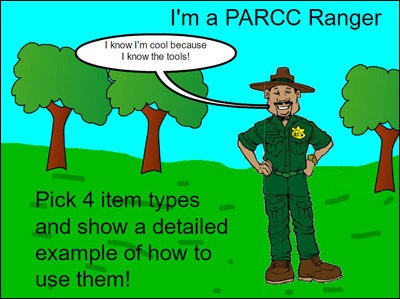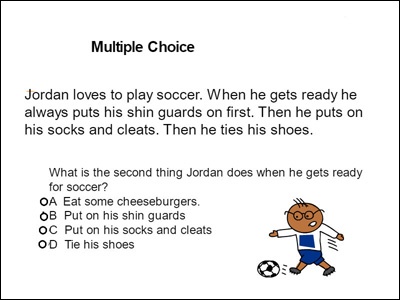



"Please, not another day of test prep!"
After years of listening to my students react to boring test prep drills and practice, it was time for a change. I still needed to do test preparation, but decided to instead do it with a project that fostered real learning and authentic creativity. As I thought about various ideas, I wondered if students would be more engaged if practice questions were about Pokemon, Star Wars, Princesses or Disney shows?
Many of the language arts questions that students encounter on the test deal with different relationships in a story: how one character feels about another, how the main characters feel about major plot events, or how the setting affects the plot of the story. Many times my students can't make those connections because they don't relate to the material. But, when we talk about their favorite heroes from TV, movies, and sports, they understand these relationships better and can then make better connections to the text.
But rather than jumping in and writing my own “fun” questions, I decided to take a more student-centered approach. I thought, “what better way to help them become familiar with these types of problems than to recreate the item types used in PARCC tutorials?”

I challenged my students to create a Wixie project with at least two original math and language arts questions on topics they were actually interested in and the I'm a PARCC Ranger project was born!
"The better you become at being a test-maker, the better you become at being a test-taker."
Since some of the item types that students encounter on the PARCC assessment are very different from what they see in the everyday classroom, I began by sharing examples of all different item types:
I showed students how to use Wixie's authoring tools to create graphs, number lines, and fraction models. I also showed them how to take screen shots of drop down menus, glue them to the paint layer, cover with white paint, and put their own answer choices on top. The Wixie library was also an excellent source of information for kids, providing them with plenty of resources to build PARCC-like questions.
I explained that many of the language arts questions on the test would fall into one of three categories:
1. Literal Questions
These questions had answers that were “right there.” You could find the answer just by going back and doing some close reading of the text.
2. Inferential Questions
These questions involved making an inference or drawing conclusion from the information given, sort of like a detective.
3. Research Based Questions
These questions often require you to use facts from non-fiction text to discover the answer.
We talked about all three question types and I shared examples of each. Then, I encouraged students to use these types of questions in their project work.

Many students lose concentration halfway through a big test and stop checking their answers carefully, so we also talked about distractors: wrong answers that distract you from the best answer. The better you make your distractors, the harder the question is to answer correctly. We looked at more examples to show how good distractors may contain information that is true, but are not the best answer.
Creating a “good” wrong answer takes some thinking and some computation. We talked about imagining the test taker making simple math errors, such as placing the wrong digit in the tens column and not regrouping correctly.
As students worked on their questions and tasks, they explored (and learned) the key places a test taker might make a simple mistake. They then used these mistakes to create answer choices that would require their "test takers" to stop, think, and recheck their work.
My students loved the chance to put their own creative spin on their questions. I was pleased to see how quickly the entire class opened up Wixie, and began using different strategies to create their questions. As they worked independently to create questions, I was able to walk around the room to assess who was having difficulty thinking of topics or using digital tools to express their ideas.
Because they were most familiar and comfortable with multiple choice questions, many of the students only used this type of item, and I had to remind them to create four questions each with a different item type. I demonstrated how to change multiple choice questions into multiple select questions by adding answer choices. I also showed how they could move text boxes around, place a box around the text, and make it look like a drag and drop problem.
I had good participation when I stopped for questioning, and the whole class was very excited to work on their projects at home. Not only did I feel like my students could relate to the lesson, if anyone in class had difficulty taking screen shots, building tasks in Wixie, or developing questions, they collaborated to help each other solve problems!
After completing this project, students couldn't wait to see the types of questions their friends created. There was a special kind of buzz in the air... the kind of buzz you feel when authentic learning is taking place in the classroom.
For students to do well on the PARCC assessment, it is essential for them to understand the type of questions they will be asked and there is no better way for students to learn about the questions than to create their own.
When students are given a chance to put learning in their own hands, the possibilities are endless. I can't wait to design more constructivist experiences to increase the educational outcomes of my students in the future!